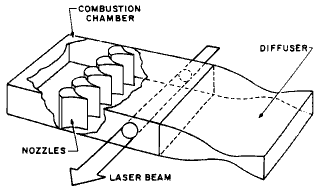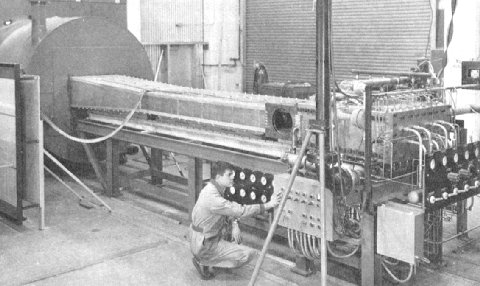In 1962 Basov and Oraevskii proposed that rapid cooling could produce population inversions in molecular systems. A few years later others suggested that this could be accomplished by expansion of a hot gas through a supersonic nozzle. And in 1966, the first gasdymamic laser was successfully operated at the Avco Everett Research Lab. (Gerry, 1970).
According to Anderson (1976) gas dynamic lasers are first cousins to rocket engines. They also share design similarities with supersonic wind tunnels. In rocket nozzles, aerodynamicists work hard to create equilibrium flows so as to obtain maximum specific impulse; on the other hand in a laser, all possible efforts are made to produce a highly non-equilibrium expansion.

Adiabatic Expansion Cooling Gasdynamic Laser : Hot gases expand through
appropriately shaped nozzles from a high pressure, high temperature chamber
into a low pressure chamber. This creates a highly non-equilibrium region were
a strong population inversion takes place. Very high laser output power can be
achieved. The diffuser is used to shock down the supersonic flow to subsonic
speeds, then the gases are generally exhausted to the atmosphere.
Population inversions require that the lasing medium be forced as far as possible from equilibrium. In equilibrium, statistical thermodynamics tells us that the upper levels have an exponentially decreasing population as a function of increasing energy, which means that the lower quantum levels have a larger population than the upper levels, thus a photon is more likely to cause an absorption. In highly non-equilibrium situations, the populations are reversed and the upper level is overpopulated relative to the lower level, and a photon is more likely to induce a stimulated emission, hence laser action is possible.
 |
| Large scale 135 Kilowatt gasdynamic laser at Avco Everett Research Lab, Inc. was among the first very high power lasers. Initially this research was classified by the U.S. government, even today information on these types of lasers is scarce. (Gerry, 1970) |
Non-equilibrium turbulent flows are much more likely to occur in rapidly expanding stellar atmospheres where ideal equilibrium flows are rarely encountered. If adiabatic expansion alone can produce one of the most powerful lasers on earth; this mechanism should also be one of the most prevalent astrophysical means of producing laser action.
PRACTICAL USE
High power CO2 lasers are used in manufacturing for drilling, cutting, welding, heat-treating and alloying (LaRocca, 1982). Some of these lasers are so powerful that beams emerging from the chamber could potentially destroy the optics. For a time the gasdynamic laser was seriously considered for use in the space based Strategic Defense Initiative (SDI) or Star Wars program.
REFERENCES
- Anderson,J.D.: 1976, Gasdynamic Lasers: An Introduction, Academic Press, New York.
- Basov,N.G., Oraevskii,A.N.: 1963, Sov.Phys.JETP., 17, 1171.
- Gerry,E.T.: 1970, IEEE Spectrum, 7, 51.
- LaRocca,A.V.: 1982, Scientific American, (March) page. 94, 'Laser Applications in Manufacturing',
- Industrial Laser Review (from PennWell Publishing Co.)
- WWW : NASA Technical Reports on aerodynamic research (NTRS)
- Minucci,M.A.S., Oliva.J.L.S.: 1993, AIAA PAPER 93-3187, 24 th Plasmadynamics and Lasers Conference On the development of a gas generator for CO2-N2 gas dynamic lasers utilizing liquid fuel and liquid oxidizer
- Biriukov,A.S., Konoplev,N.A., Shcheglov,V.: 1981, Pis'ma v Zhurnal Tekhnicheskoi Fiziki, 7, 482. Energy capabilities of a three-frequency periodic-pulse CO2 gas-dynamic laser
- Krause,S., Maisenhaelder,F.: 1980, Applied Optics, 22, 421. Gasdynamic CO laser with closed-cycle gas flow
- Huegel,H., Schall,W., Hoffmann,P.: 1976, DFVLR-Nachrichten, (Nov), 784. Gas dynamic CO2 laser output increase with the aid of appropriate supersonic mixing techniques
- Murthy,S.N.B.: 1976, in High-power gas lasers, Summer School (IOP), Capri,, Italy, September 1975, p.222 Gas-dynamic and chemical lasers - Gas dynamics
- Fournier,G., Morency,J.P.: 1975, NASA DREV-4011/75 Preliminary analysis of a light-gas gun-driven gas dynamic laser
- Cavalleri,R.J.: 1975, in Hydrogen energy, Proc., Miami Beach,, Fla., Plenum Press, p. 677 A hydrogen-fueled gas-dynamic laser
- Shmelev,V.M., Vasilik,N.IA., Margolin,A.D.: 1974, Kvantovaia Elektronika (Moscow), 1, 1711. Gas dynamic CO2+N2+CO+H2O laser
- Genaralov,N.A., Kozlov,G.I., Selezneva,I.K.: 1974, NASA AD-783445, Air Force Systems Command, Wright-Patterson AFB, OH. Estimate of the characteristics of a gas-dynamic laser
- Biryukov,A.S., Marchenko,V.M., Shelepin,L.A.: 1974, NASA JPRS-63317, Joint Publications Research Service, Arlington, VA. Gas dynamic laser with electric excitation of a thermally ionized gas
- Pallay,B.G., Zovko,C.T.: 1973, AIAA PAPER 73-1233 Fuels, oxidizers and gas generators for gas dynamic lasers
- Yatsiv,S., Greenfield,E., Dothan-Deutsch,F., Chuchem,D.: 1972, in Laser Engineering and Applications IEEE Journal of Quantum Electronics, vol. QE-8, Feb. 1972, pt.,2, page 161. Experiments with a pulsed CO2 gas dynamic laser. (combustion driven)
- McMahan,W.H.: 1971, Optical Spectra, 5, 30. High-power, visible-output, gas-dynamic lasers.
Supersonic Wind Tunnels
- Flow field diagrams of hypersonic nozzles by H.L.Boerrigter,
- Soeder,R.H.: 1992, NASA TM-105626. Lewis 10 X 10-Foot Supersonic Wind Tunnel
- NASA Wind Tunnels, in particular the 9 X 7 foot Supersonic test section
- EL-1996-00048 - The NASA Langley Research Center Unitary Plan Wind Tunnel
- Transonic and Supersonic Wind Tunnels
- NASA MSFC 14 inch Trisonic Wind Tunnel and Nozzle test facilities (Fluid Dynamics Division)
- Davidian et al.: 1987, Rocket Nozzle Tests, NASA TM 89814 AIA-87-2971 (from Liquid Rocket Engine Performance Research)
- Nonstationary Gasdynamics, Computational Fluid Dynamics and Hypersonics - J.J.Gottlieb
- Supersonic Wind Tunnel Computational Fluid Dynamics - Korte et al. (NASA)
- Virtual Wind Tunnel and Ideal Flow Machine (Java applets)
- Computational Fluid Dynamics Online Resources